Greater Underwater Propulsion Power
Program
from Wikipedia
| The Greater Underwater Propulsion Power Program
(GUPPY) was initiated by the United States Navy after World War II to improve
the submerged speed, maneuverability, and endurance of its submarines.
(The "Y" in the acronym was added for pronounceability.)
The navy began the program by testing and reverse
engineering two captured German Type XXI U-boats: U-2513 and U-3008. That
analysis led to four goals-increasing the submarines' battery capacity,
streamlining the boats' structures, adding snorkels, and improving fire
control systems. The navy immediately focused on designing a new class
of submarines, but the Bureau of Ships believed that the vast fleet of
existing Gato, Balao, and Tench class submarines could be modified to incorporate
the desired improvements. In June 1946, the Chief of Naval Operations approved
the GUPPY project. The initial |
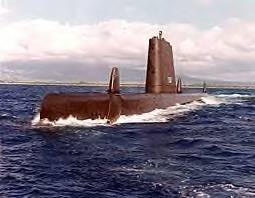
USS Greenfish (SS-351) after GUPPY
III modernization |
two boat test program, implemented by the Portsmouth
Naval Shipyard, eventually grew into several successive conversion programs.
Those upgrades proceeded in seven variants, in the following order: GUPPY
I, GUPPY II, GUPPY IA, Fleet Snorkel, GUPPY IIA, GUPPY IB, and GUPPY III.
Some boats that went through an early phase were then upgraded further
in a later phase.#
A similar programme for the Royal Navy involved
modifications to 24 wartime and post-war British T-class and A-class submarines,
which were provided with streamlined hulls, sail-type conning towers, and
increased underwater performance during 1948-60.
GUPPY I program
The prototype GUPPYs, Odax and Pomodon (both Portsmouth-built
Tench boats), appeared in 1947. Externally, they featured improved streamlining
of the bridge and shears structures, and periscope and radar mast supports.
To reduce hydrodynamic drag, one of the periscopes was deleted. No snorkel
was fitted, due to difficulties in adapting the snorkel to the fleet boat.
Deck guns and their associated containers were removed. An SV radar aerial
was added to the top of the sail, creating a distinctive side bulge. All
capstans, cleats, and rail stanchion supports were redesigned so they could
be retracted or removed when rigged for dive. Most notably, the sharp V-shaped
"fleet boat bow" was replaced with a distinctive rounded "Guppy bow" that
improved submerged performance.
These modifications changed not only the boats'
appearance, but also their terminology: After a GUPPY conversion, the faired
structure around the boat's conning tower and mast supports was called
the "sail".
Internally, the boats underwent considerable rearrangement
to accommodate larger battery wells and batteries of greatly increased
electrical power. The batteries were of a new design. Compared with the
original Sargo battery, the Guppy battery used a greater number of thinner
plates that would generate higher current for a longer time. However, these
batteries had a shorter life, 18 months versus the five years of the Sargo
battery, and took longer to charge. They also required ventilation to remove
hydrogen gas, and required cooling water to the battery terminals and termination
bars. Four 126-cell batteries were installed in enlarged battery wells
that replaced former storage, ammunition, and refrigeration spaces. These
four batteries could be connected in series or parallel, providing a wide
range of voltages and currents, and thus a wide range of speeds.
In the maneuvering room, two or four of the earlier
high-speed motors and reduction gears were replaced by slow-speed motors.
All open-front switchboards were replaced with enclosed splash-proof cabinets.
Lighting and other "hotel" electrical loads were converted to use 120 volt
60 hertz alternating current, and ship electronics to use 120 volt 400
hertz AC. A new air conditioning system of greatly increased capacity was
also installed.
In service, these boats offered greatly improved
underwater performance. Pomodon reached 17.8 knots surfaced and 18.2 knots
(33.7 km/h) as compared to the previous performance of 20.25 knots surfaced
and 8.75 knots (16.20 km/h) submerged, Odax slightly less.
GUPPY I boats
Odax
(Became Rio de Janeiro (S-13)
Brazilian Navy)
Pomodon |
GUPPY II program
The GUPPY II conversion (SCB 47), implemented
from 1947 to 1951, was generally similar to the GUPPY I, except for retention
of both periscopes and introduction of the recently perfected snorkel.
The addition of three new masts-snorkel induction, snorkel exhaust, and
ESM mast—required more room in the upper portion of the sail. BuShips approved
two different sail designs:
| The "Electric Boat Sail" had a straight trailing
edge, round windows, a wider top and a more rounded forward edge.
The "Portsmouth Sail" had a thinner top, curved
trailing edge, square windows and a sharper lower forward edge. It was
put on all boats that used the government plans for the conversion. |
All boats converted during the GUPPY II program
that originally had high-speed drive motors with reduction gears had these
replaced with low-speed direct-drive motors, producing 2500 horsepower
(1.9 MW) per shaft.
|
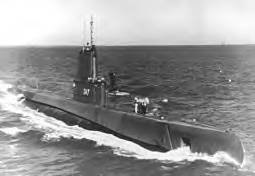
USS Cubera (SS-347), after GUPPY
II modernization
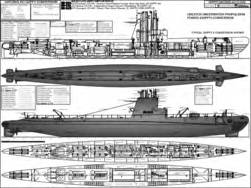
|
The two GUPPY I boats, Odax and Pomodon, were modified
to GUPPY II standard.
GUPPY II boats
Catfish (became ARA Sante Fe (S-21)
Argentine Navy)
Clamagore
Cobbler
Cochino
Corporal
Cubera
Diodon
Dogfish (Became Guanabara (S-10) Brazilian Navy) |
Greenfish
Halfbeak
Tiru
Trumpetfish
(Became Goiás (S-15)
Brazilian Navy)
Tusk
(Became Hai Pao
(SS-792) Republic of
China Navy) Active
in
service
Cutlass
(Became Hai Shih
(SS-791) Republic of
China Navy) Active
in
service
Amberjack
(Became Ceará (S-14)
Brazilian Navy) |
Odax
Sirago
Pomodon
Remora
Volador
Sea Leopard
(Became Bahia (S-12)
Brazilian Navy)
Grampus
(Became Rio Grande do
Sul (S-11)
Brazilian Navy)
Pickerel
Grenadier |
GUPPY IA program
BuShips devised the GUPPY IA (SCB 47A) program
of 1951 as a cheaper alternative to the GUPPY II conversion. While the
GUPPY IA conversion included most features of the GUPPY II, it omitted
the four-cell battery configuration and extensive internal rearrangement
associated with it. Instead, the GUPPY IA retained the original battery
wells, fitted with more powerful Sargo II batteries. These batteries featured
electrolyte agitation, battery cooling, and open tank ventilation. They
also had a longer life than the Guppy batteries, though shorter than the
original Sargo battery. The sonar room was relocated from the forward torpedo
room to a space under the galley. Compared to the GUPPY II, the GUPPY IA
offered lower cost, better habitability, and easier maintenance at the
expense of underwater performance.
GUPPY IA boats
Becuna
Blackfin
Caiman
Blenny
Chivo
(became ARA Santiago del
Estero SS-22
Argentine Navy) |
Chopper
Atule
Sea Poacher
Sea Robin
Tench |
Fleet Snorkel Program
| When the navy realized that it would
not be able to fund all the GUPPY conversions it desired, it devised the
Fleet Snorkel Program (SCB 47B) as a means of adding the minimum necessary
modifications to fleet boats. This modernization added a snorkel, a streamlined
sail, a higher capacity air-conditioning system, and a more powerful electrical
system. The deck guns and auxiliary diesel were removed. Unlike the GUPPY
conversions, these boats retained their original deck structure, bow, and
storage batteries. Submerged performance of the Fleet Snorkel boats was
therefore significantly inferior to any GUPPY conversion. Despite their
limited features, the Fleet Snorkel boats served almost as long as the
more modern GUPPY boats. Three boats, Piper, Sea Owl, and Sterlet, received
a large BQR-4A bow sonar. |
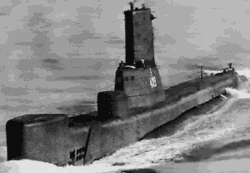
USS Piper (SS-409) with BQR-4A
bow sonar |
Fleet Snorkel boats
Sabalo
Sablefish
Bergall
Besugo
Charr
Bugara
Carbonero
Carp
Cusk
Kraken |
Lizardfish
Mapiro
Mero
Sterlet
Scabbardfish
Segundo
Sea Cat
Sea Owl
Sennet |
Spinax
Piper
Torsk
Argonaut
Runner
Diablo
Medregal
Requin
Irex |
GUPPY IIA program
| The GUPPY IA program was succeeded by the nearly
identical GUPPY IIA program (SCB 47C), implemented from 1952 to 1954. The
GUPPY IIA, however, further alleviated the cramped internal conditions
of earlier conversions by removing one forward engine and replacing it
with pumps and air conditioning machinery. Some boats had the high-pressure
air compressors relocated to the lower level of the forward engine room.
The freezer and refrigerator units were moved to the space under the galley,
and the sonar room was relocated to the forward end of the pump room. Sargo
II batteries were installed in the existing battery wells. |
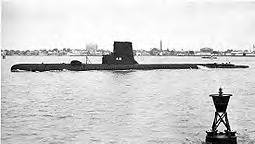
USS Thornback (SS-418) after
GUPPY IIA modernization |
Externally, the GUPPY IIA differed from the GUPPY
II and IA by having only three diesel exhaust outlets, whereas the earlier
conversions had four.
GUPPY IIA boats
Entemedor
Diodon
Hardhead
Jallao
Menhaden
Picuda |
Bang
Pomfret
Razorback
Ronquil
Sea Fox
Threadfin |
Stickleback
Thornback
Tirante
Trutta
Quillback |
GUPPY IB program
GUPPY IB was an informal designation for a limited
upgrade and modernization given to four boats for transfer to foreign navies.
These boats had snorkels and were generally similar to the GUPPY IA, except
that they were not equipped with the modern sonar, fire control systems,
or ESM. The two Italian boats were of the thin-skinned Gato class.
GUPPY IB boats
Barb (became ITNS Enrico Tazzoli
(S-511) Marina Militare)
Dace (became ITNS Leonardo
da Vinci (S-510) Marina Militare)
Hawkbill (became HNLMS Zeeleeuw
(S-803) Royal Netherlands Navy)
Icefish (became HNLMS Walrus
(S-802) Royal Netherlands Navy)
GUPPY III program
| The GUPPY II conversions suffered from very cramped
internal conditions due to the four-battery configuration. The GUPPY III
program (SCB 223) was devised to address this problem. In 1959, Tiru became
the prototype conversion. It was cut in half and lengthened with a 12.5
foot (3.8 m) section forward of the control room to create space for a
new sonar room, berthing, electronics, and storerooms. The removal of the
sonar room from the forward torpedo spaces allowed an increase in the number
of reloads. Crew spaces were also refurbished. As in the GUPPY IIA conversion,
one diesel engine was removed.
From 1961 to 1963, eight more GUPPY II boats were
upgraded to GUPPY III standard. These boats differed from Tiru by adding
a 15 foot (4.6 m) section forward of the control room. They also retained
all four diesel engines. This increased the boat's length to 322 feet (98
m) and raised surfaced displacement to approximately 1,975 tons.
|
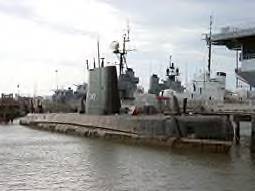
USS Clamagore (SS-343) after
GUPPY III modernization |
All boats received the BQG-4 PUFFS passive ranging
sonar, identifiable by the three fin-like sonar domes added to the superstructure.
The conning tower in the sail gained an additional five foot (1.5 m) section
to accommodate the Mk 101 fire control system and Mk 37 director. All GUPPY
III boats received a plastic sail.
The GUPPY III conversion was part of the Fleet
Rehabilitation and Modernization (FRAM) program. All 24 GUPPY II boats
were originally slated to receive the GUPPY III upgrade, but budgetary
constraints limited the program to a total of nine boats. Despite their
extensive modifications and upgrades, the GUPPY III boats served only slightly
longer than the rest of the GUPPY fleet.
GUPPY III boats
Clamagore
Cobbler
Corporal
Greenfish
(became Amazonas (S-16)
Brazilian Navy)
Tiru |
Trumpetfish
(became Goias (S-15)
Brazilian Navy)
Remora
Volador
Pickerel |
|